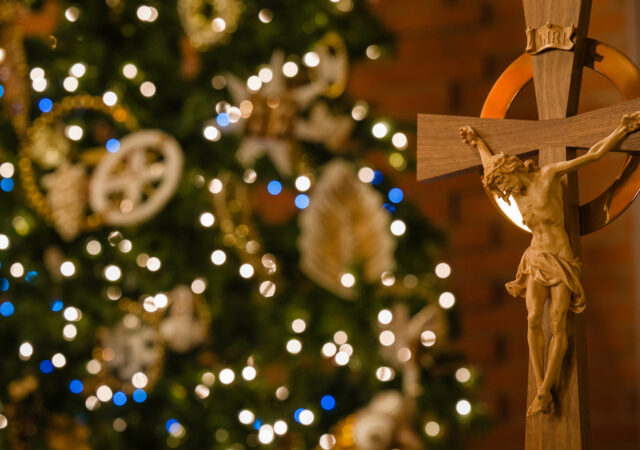NEW ORLEANS (RNS) — Not much keeps Archbishop Gregory Aymond up at night. But one thing does make him toss and turn.
In the past four years, especially after Hurricane Katrina, Catholic school enrollment has been steadily falling. Finding ways to reverse the trend has been the most challenging work of his administration.
“It worries me,” Aymond said. “There is a decline and there has been a decline for the last several years, nationally as well as locally.”
Catholic schools took a hit from Hurricane Katrina in 2005 and have continued losing students since, with enrollment dropping almost 5 percent since 2007, from 40,625 to 38,434. It’s down 19 percent from pre-Katrina levels, and with 20 fewer schools.
Nationally, Catholic school enrollment has shrunk 20 percent over the past decade, from 2.6 million to 2.1 million students, according to the National Catholic Educational Association. More than 1,600 schools have closed or consolidated, with elementary schools taking the biggest hit.
Earlier this month, the Archdiocese of New York proposed shuttering 32 schools in what church officials described as the largest reorganization in that school system’s history. In Baltimore, 13 parochial schools are set to close.
“It’s significant, and it’s disturbing,” said Sister Dale McDonald, the national association’s public-policy director. “We’re talking about a half-million students.”
The reasons for the decline, both nationally and locally, are numerous. Families are smaller, tuition is higher and public charter and magnet schools are more popular than ever.
The trend is especially surprising in the New Orleans area, where the percentage of students attending nonpublic schools has historically been one of the highest in the United States.
Linda Kleinschmidt of Metairie enrolled her daughter, Eva, in the co-ed Haynes Academy for Advanced Studies magnet school — the state’s second-ranked public high school — over the all-girls St. Mary’s Dominican High School.
“It was not a matter of money,” Kleinschmidt said. “It was more a difference in the social and academic environment that single-sex schools cannot offer. We are happy so far with the decision.”
Ben Kleban, founder and director of New Orleans College Prep Charter School, said that while most of his students come from other public schools, he’s seeing a rise in applicants coming from Catholic schools.
“I’m hearing more and more from parents that it doesn’t make sense for them to pay tuition if we can provide as good or better education than what they are getting at a parochial school,” Kleban said.
Lynn Jenkins, admissions director at Benjamin Franklin High School, the state’s top public high school, said the number of new students from Catholic schools rose from 29 to 46 this year. Such switches are becoming increasingly common.
“Charter and magnet schools have definitely affected our enrollment, and we know that,” Aymond said.
But while specialized public schools offer a good education, Aymond thinks families are leaving Catholic schools for economic reasons. The average tuition for elementary school is $3,400 a year; for high school, $8,000.
“Catholic education is expensive,” Aymond said. “We not only provide excellent (secular) education, but we provide excellence in the teaching of the Catholic faith. It worries me, as I look toward the future. We do not want Catholic education to be something for the elite. That would go against our whole philosophy.”
The archbishop says “we have to start thinking outside the box,” and that process will begin in January when the archdiocese embarks on a comprehensive strategic plan with experts from Catholic University in Washington.
“We will be looking at trends, what schools may not be viable in the future, the application process, how much we are able to give (in
scholarships) in a given year,” Aymond said. “We need to think big, and we need to think different.”
Catholic University professors John Convey and Leonard DeFiore plan to dissect every aspect of the area’s Catholic school community. In addition to meeting with the top leadership, they want to hear from pastors, teachers, principals, parents and students.
“We’ll have a number of public meetings,” said Convey, who has done similar work in other cities. “We’ll ask people what, from their perspective, are the challenges and the problems.”
Aymond will then appoint a steering committee to work with Convey and DeFiore, and together they will develop a set of recommendations for the archdiocese.
Among other issues, the researchers will look at demographics to determine the possibility for future growth and the need for further school consolidation and closings. The archdiocese, meanwhile, will work to boost enrollment — from increasing advertising, to pushing open-house attendance, to fundraising.
“We have made conscious and tangible efforts to put the word out,” Aymond said, “to remind people that Catholic schools are available, what their purpose is and invite them in.”
Aymond said he is convinced that such efforts could reclaim families who are leaving Catholic schools for financial reasons.
“We, as the bishops of the country, put out a statement in strong support of Catholic education being available and affordable to all,” Aymond said. “I believe in that statement. There is something unique and valuable about Catholic schools, something children cannot get anywhere else.”
— Barri Bronston (The Times-Picayune, New Orleans)
© 2010 Religion News Service. Used with permission.
Posted Dec. 2, 2010




